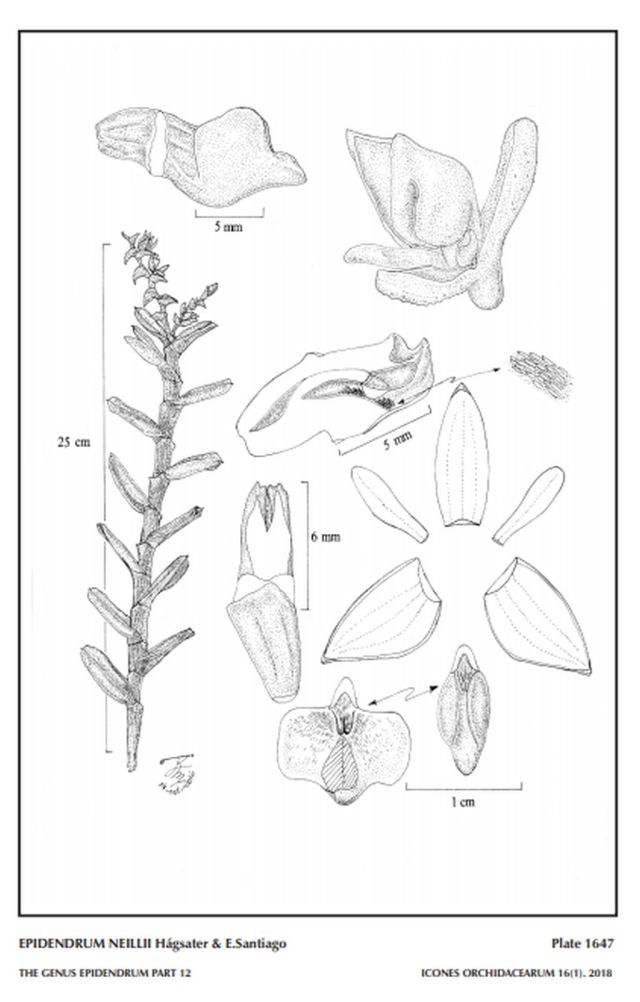

Epidendrum neillii Hágsater & E.Santiago 2018 GROUP Aquaticum
TYPE Drawing © by R Jimenez and The AMO Herbario Website




Common Name Neill's Epidendrum [American Research Director and Professor at the Herbario Amazónico del Ecuador, Universidad Estatal Amazónica (ECUAMZ), in Puyo, Pastaza, Ecuador current]
Flower Size .6" [1.5 cm]
Found in southern Ecuador and northern Peru on the Machinaza plateau of the Cordillera del Condor occuring on a nearly level sandstone plateau with low scrub vegetation at elevations around 2420 meters as a small sized, cold growing terrestrial with cane-like, terete, erect, probably subapically branching stems carrying 13 or more on the single stem seen, distributed throughout, alternate, articulate, coriaceous, very rigid, fleshy, sub-spreading, all similar in size and shape with tubular, striated, rugose sheaths; blade oblong-elliptic, obtuse, minutely apiculate, margin entire, revolute leaves that blooms in the fall on a terminal, without a spathe, peduncle .2" [5 mm] long, sub-terete; rachis slightly sinuous, 2.4" overall [6 cm] long, apical, paniculate, with a small second raceme arising from near the base of the peduncle, sub-erect, simultaneously to 14 flowered inflorescence with prominent, longer than the ovary, widely ovate, cucullate, subacute, embracing, rigid, forming a right angle with the rachis floral bracts and carrying . fleshy, non-resupinate, greenish yellow flowers with the lip and column lemon yellow and the fragrance not registered.
"Epidendrum neillii belongs to the GROUP Aquaticum which is characterized by the monopodial, branching habit, the distichous, and erect to arching-nutant inflorescence, with fleshy flowers, and the disc of the lip and/or nectary often pilose. The species is recognized by the leaves 2.5-3.6 x 1.0-1.8 cm, oblong-elliptic with the margin revolute, inflorescence sub-erect and few-flowered with prominent floral bracts (5-10 x 6-10 mm), sepals 11 mm long, petals .33" x .094" [8.3 x 2.4 mm], oblanceolate with the apex rounded, and the lip entire with base truncate. Epidendrum alsum has similar-sized leaves but ovate, inflorescence nutant, sub-densely many-flowered, floral bracts small .2 to .26" x .16 to .2" [5 to 6 x 4 to 5 mm], embracing, sepals .32 to .36" [8 to 9 mm] long, petals .28 to .36 x .76 to .84" [7 to 9 x 1.9 to 2.1 mm], narrowly oblanceolate, apex acuminate, and the lip 3-lobed, base cuneate. Epidendrum urbanianum Cogn. has oblong-lanceolate leaves 1 to 3.8" x .4 to .8" [2.5 to 9.5 x 1.0 to 2.0 cm], inflorescence arching with the bracts nearly as long as the flower .2 to .48" x .28 to .4" [5 to 12 x 7 to 10 mm]; sepals .28 to .4" [7 to 10 mm] long, and petals linear, .22 to .28" x .4 to .6" [5.5 to 7.0 x 1.0 to 1.5 mm]. Other species related to this group from the Andean tepuys are Epidendrum stenocalymmum Hágsater & G.Calatayud, which has very similar floral bracts and flowers in size and shape, but the inflorescence is racemose, leaves 1.2-2.1 x 0.9-1.2 cm, ovate; petals 7.7-8.0 x 2.0-2.2 mm, oblanceolate with the base unguiculate, and base of the lip cuneate. Epidendrum lindamazonicum Hágsater & G.Calatayud has narrowly lanceolate-elliptic, leaves .56 to 1.08" X .12 to .2" [1.4 to 2.7 x 0.3 to 0.5 cm], inflorescence erect with small floral bracts .12 to .28 x .08 to .16" [3 to 7 x 2 to 4 mm), sepals .32" [8 mm] long, petals .023 x .16 to .44" [5.7 x 0.4 to 1.1 mm], linear, acuminate, and lip with a single apiculate callus. Epidendrum campylorhachis Hágsater & Dodson has narrowly elliptic, leaves .84 to 1.76" x .16 to .44" [2.1 to 4.4 x 0.4 to 1.1 cm], inflorescence with the rachis flexuous, with each segment incurved below the bract so that the bracts are retrorse, .088 to .16" x .12 to .16" [2.2 to 4.0 x 3.0 to 4.0 mm], flowers small, sepals .208 to .22" [5.2 to 5.5 mm] long, and base of the lip cuneate." Hagsater 2018
Synonyms
References W3 Tropicos, Kew Monocot list , IPNI ; *Icones Orchidacearum 16[1] Plate 1647 Hagsater & Sanchez 2018 drawing/photo fide; Icones Orchidacearum 17(1) Plate 1781 Hagsater & Jimenez 2019 see recognition section;
----------------------------------------------------------------------------------------------------------